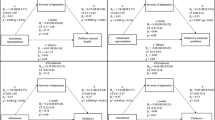Abstract
This study compares attachment trauma and psychological adjustment of child survivors of an earthquake and social violence in Gujarat (n = 127). In particular it explores attachment style/s associated with the two disaster traumas and tries to explicate, what these tell us about the particular vagaries of trauma. Results show larger number of insecurely attached children in the disaster trauma sample and the dismissing attachment style dominates particularly in the earthquake sample whereas in the riots sample one can see a presence of what can be termed as a ‘mixed attachment’ style-vacillation between dismissing and preoccupied states of mind. The implications of these findings for a conceptualization of attachment trauma are discussed in details.
Similar content being viewed by others
Notes
See, Table 8 at the end of the paper for CAI questionnaire.
References
Catani, C., Schauer, E., Elbert, T., Missmahl, I., Bette, J.-P., & Neuner, F. (2009). War trauma, child labor and family violence: life adversities and PTSD in a sample of school children in Kabul. Journal of Traumatic Stress, 22(3), 163–171. doi:10.1002/jts.20415.
Fonagy, P. (2004). The roots of social understanding in the attachment relationship: an elaboration on the constructionist theory. Behavior and Brain Sciences, 27(1), 105–106. doi:10.1017/S0140525X04320030.
Fonagy, P., & Target, M. (1997). Attachment and reflective function: their role in self-organization. Development and Psychopathology, 9(4), 697–700. Retrieved from http://www.journals.cambridge.org/production/action/cjoGetFulltext?fulltextid=43496.
Fonagy, P., Leigh, T., Steele, M., Steele, H., Kennedy, R., & Mattoon, G. (1996). The relation of attachment status, psychiatric classification, and response to psychotherapy. Journal of Consulting and Clinical Psychology, 64, 22–31. Retrieved from http://www.linkinghub.elsevier.com/retrieve/pii/S0022006X0200935X.
George, C., Kaplan, N., & Main, M. (1985). The adult attachment interview. Unpublished protocol: University of California, Berkeley.
Goodman, R. (1997). The strengths and difficulties questionnaire: a research note. Journal of Child Psychology and Psychiatry, 38, 581–596. doi:10.1111/j.1469-7610.1997.tb01545.x.
Goodman, R. (1999). The extended version of the strengths and difficulties questionnaire as a guide to child psychiatric caseness and consequent burden. Journal of Child Psychology and Psychiatry, 40, 791–801. doi:10.1111/1469-7610.00494.
Human Rights Watch Report (Internet). ‘We have no orders to save you’ PUCL Bulletin 2002, [Accessed on 22 January 2009] Weblink: http://www.pucl.org/Topics/Religion-communalism/2002/hrw.htm
Kakar, S. (2001). The essential writings of Sudhir Kakar. New Delhi: Oxford University Press.
Kaplan, S. (2006). Children in genocide: extreme traumatization and the ‘affect propellor’. International Journal of Psycho-Analysis, 87, 725–746. doi:10.1516/9C86-H1RG-K3FF-DRAH.
Kumar, M. (2007). A journey into the bleeding city: following the footprints of the rubble of riots and the violence of the earthquake in Gujarat. Psychology and Developing Societies, 19(1), 1–37. doi:10.1177/097133360701900101.
Kumar, M. (2010). Politics of exclusion and social marginalization of Muslims in India: case study of Gujarat. Journal of Applied Psychoanalytic Studies, 7(3), 209–218. doi:10.1002/aps.256.
Kumar, M., & Fonagy, P. (2011). Understanding trauma of Gujarati child survivors of two disasters: reviewing ‘attachment trauma’ using Child Attachment Interview material. Manuscript submitted to International Journal of Psychoanalysis.
Mehta, L. (2001). Reflections on Kutch earthquake. Economic and Political Weekly. 4 August, pp. 2931–2936, http://www.epw.org.in/.
Neuner, F., Schauer, E., Catani, C., Ruf, M., & Elbert, T. (2006). Post-tsunami stress: a study of posttraumatic stress disorder in children living in three severely affected regions in Sri Lanka. Journal of Traumatic Stress, 19(3), 339–347. doi:10.1002/jts.20121.
Norris, F. H., Galea, S., Friedman, M. J., & Watson, P. J. (Eds.). (2006). Methods for disaster mental health research. New York: Guildford.
Pynoos, R. S., Goenjian, A. K., Walling, D., Steinberg, A. M., Karayan, I., & Najarian, L. M. (2005). A prospective study of posttraumatic stress and depressive reactions among treated and untreated adolescents 5 years after a catastrophic disaster. The American Journal of Psychiatry, 162, 2302–2308. doi:10.1176/appi.ajp.162.12.2302.
Rimé, B. (2009). Emotion elicits the social sharing of emotions: theory and empirical review. Emotion Review, 1, 60–85. doi:10.1177/1754073908097189.
Sharp, C., Fonagy, P., & Goodyer, I. M. (2006). Imagining your child’s mind: psychosocial adjustment and mother’s ability to predict their children’s attributional response styles. British Journal of Developmental Psychology, 24, 197–214. doi:10.1348/026151005X82569.
Shmueli-Goetz, Y. (2001). Child attachment interview: Development and validation. Unpublished doctoral dissertation. University College London.
Shmueli-Goetz, Y., Target, M., Fonagy, P., & Datta, A. (2008). The child attachment interview: a psychometric study of reliability and discriminant validity. Developmental Psychology, 44(4), 939–956. doi:10.1037/0012-1649.44.4.939.
Shweder, R. A. (1991). Thinking through cultures: Expeditions in cultural psychology. Cambridge: Harvard University Press.
Sroufe, L. A. (1982). The organization of emotional development. Psychoanalytic Inquiry, 1, 575–599. Retrieved from http://www.pep-web.org/document.php?id=pi.001.0575a.
Target, M., Fonagy, P., & Shmueli-Goetz, Y. (2003). Attachment representations in school-age children: the development of the child attachment interview (CAI). Journal of Child Psychotherapy, 29, 171–186. doi:10.1080/0075417031000138433.
Van IJzendoorn, M. H. (1995). Adult attachment representations, parental responsiveness, and infant attachment: a meta-analysis on the predictive validity of the adult attachment interview. Psychological Bulletin, 117(3), 387–403. Retrieved from http://www.linkinghub.elsevier.com/retrieve/pii/S0033290902002666.
Van IJzendoorn, M. H. (1992). Intergenerational transmission of parenting: a review of studies in nonclinical populations. Developmental Review, 12, 76–99. doi:10.1016/0273-2297(92)90004-L.
Van IJzendoorn, M. H., & Bakermans-Kranenburg, M. J. (1997). Intergenerational transmission of attachment: A move to the contextual level. In L. Atkinson & K. J. Zucker (Eds.), Attachment and psychopathology (pp. 135–170). New York: Guilford.
Van IJzendoorn, M. H., & Sagi, A. (1999). Cross-cultural patterns of attachment: Universal and contextual dimensions. In J. Cassidy & P. R. Shaver (Eds.), Handbook of attachment: Theory, research, and clinical applications (pp. 713–733). New York: Guilford.
Weinfield, N. S., Sroufe, L. A., & Egeland, B. (2000). Attachment from infancy to early adulthood in a high risk sample: continuity, discontinuity and their correlates. Child Development, 71(3), 695–702. Retrieved from http://www.jstor.org/pss/1132388.
Author information
Authors and Affiliations
Corresponding author
Rights and permissions
About this article
Cite this article
Kumar, M., Fonagy, P. Conceptualizing Attachment Trauma: Exploring Emotional Vulnerabilities among Disaster Affected Children of Gujarat. Psychol Stud 57, 9–21 (2012). https://doi.org/10.1007/s12646-011-0114-x
Received:
Accepted:
Published:
Issue Date:
DOI: https://doi.org/10.1007/s12646-011-0114-x




